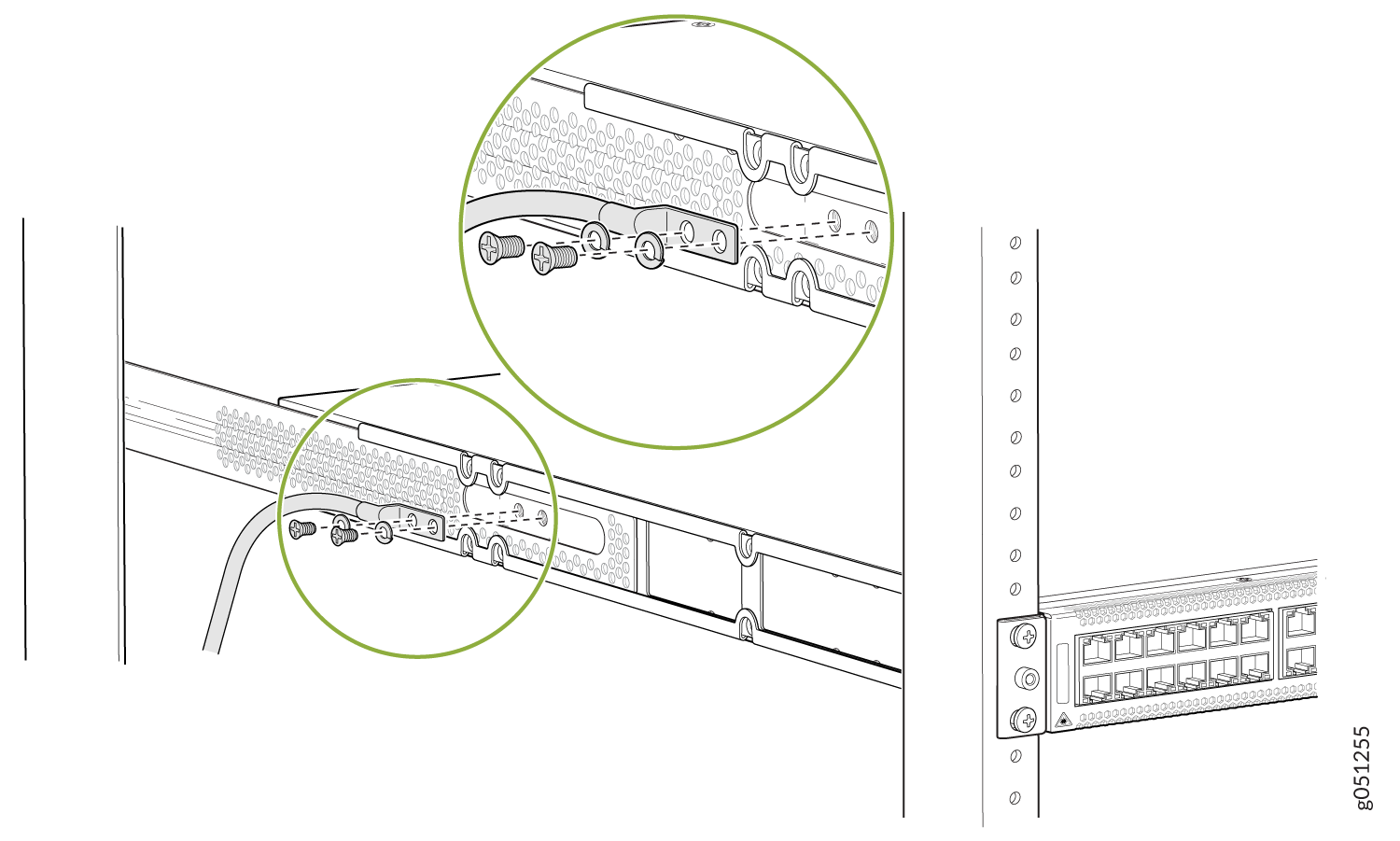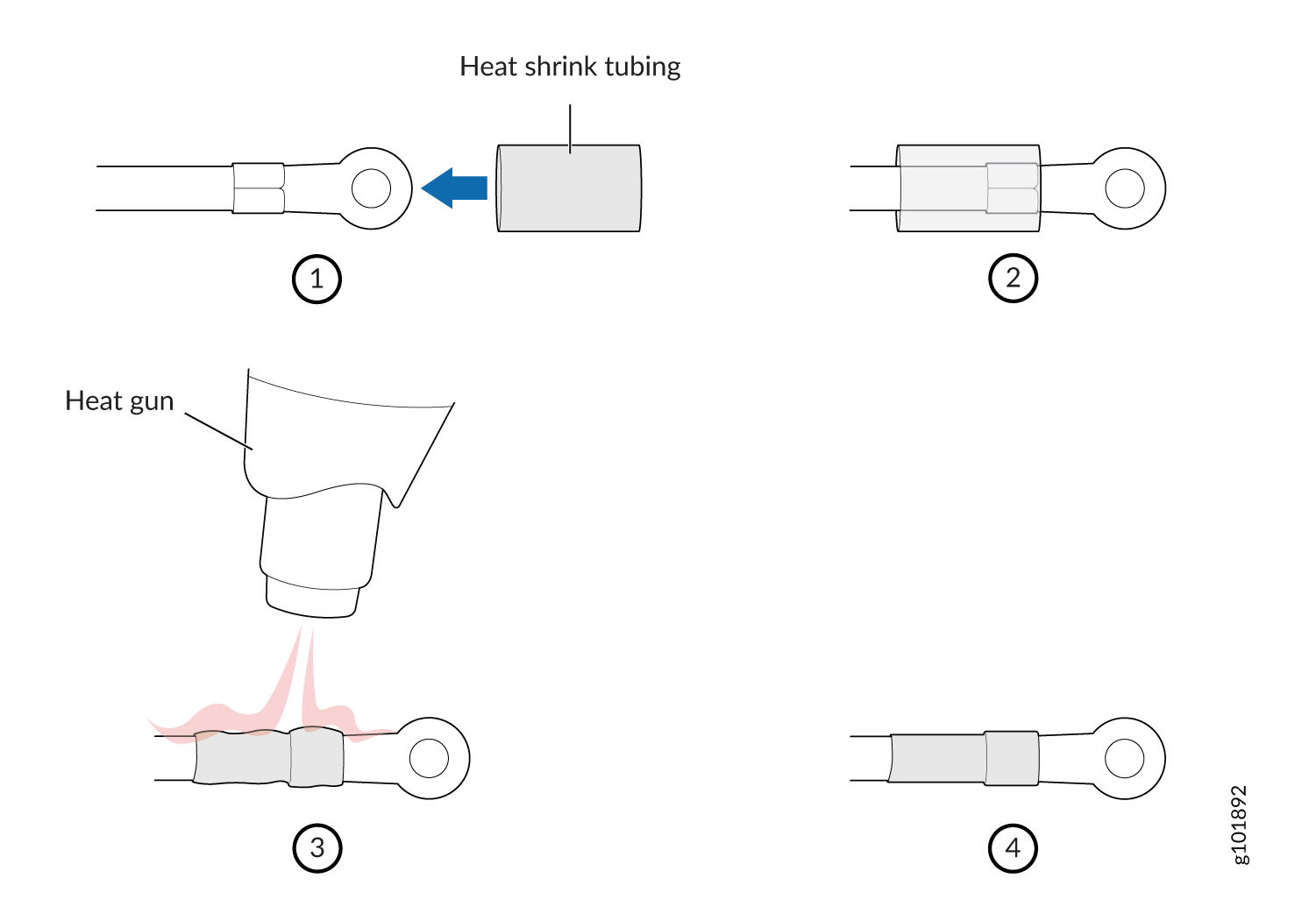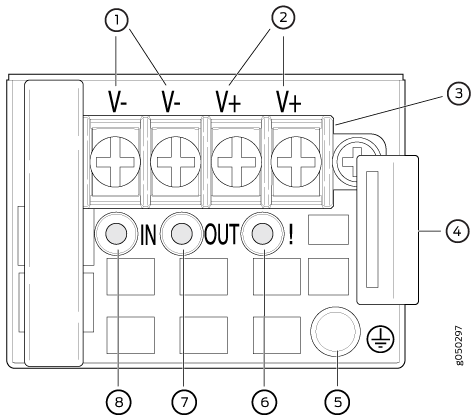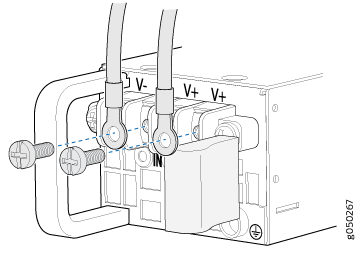Connecting the EX4650 to Power
Connect the EX4650 Switch to Earth Ground
Before you connect earth ground to a EX4650 switch, ensure that you have the following parts and tools available:
Grounding cable:
14 AWG (1.5 mm²), minimum 90° C wire, or as permitted by the local code—not provided
Grounding lug:
Panduit LCD10-10A-L or equivalent—not provided
Screws to secure the grounding lug:
Two 10-32 x .25-in. screws with #10 split-lock washers—not provided
Number 2 Phillips (+) screwdriver—not provided
ESD grounding strap—not provided
To ensure proper operation and to meet electromagnetic interference (EMI) requirements, you must connect the switch to earth ground before you connect power to the switch. You must install the switch in a restricted-access location and ensure that the chassis is properly grounded at all times.
EX4650 switches have one two-hole protective earthing terminal on the left panel. Under all circumstances, use this grounding connection to ground the chassis. For AC-powered systems, you must also use the grounding wire in the AC power cord along with the two-hole grounding lug connection. This tested system meets or exceeds all applicable EMC regulatory requirements with the two-hole protective grounding terminal.
Ensure that a licensed electrician has attached the appropriate grounding lug to the grounding cable that you supply. Using a grounding cable with an incorrectly attached lug can damage the switch.
The protective earthing terminal on EX4650 switches mounted flush with the front posts of a rack is accessible through the slot on the left rear bracket only if the distance between the front posts and the rear posts is 23 in. (58.5 cm) through 30.25 in. (76.8 cm). The protective earthing terminal on EX4650 switches mounted in a recessed position from the front posts of a rack is accessible through the slot on the left rear bracket only if the distance between the front posts and the rear posts is 25 in. (63.5 cm) through 32.25 in. (81.9 cm). AC-powered switches gain additional grounding when you plug the power supply in the switch into a grounded AC power outlet by using the AC power cord appropriate for your geographical location.
To ground the EX4650:
Connecting AC Power to an EX4650 Switch
Ensure that you have a power cord appropriate for your geographical location available to connect AC power to the switch.
Before you begin connecting AC power to the switch:
Ensure that you have taken the necessary precautions to prevent electrostatic discharge (ESD) damage (see Prevention of Electrostatic Discharge Damage).
Ensure that you have connected the switch chassis to earth ground.
CAUTION:Before you connect power to the switch, a licensed electrician must attach a cable lug to the grounding and power cables that you supply. A cable with an incorrectly attached lug can damage the switch (for example, by causing a short circuit).
To meet safety and electromagnetic interference (EMI) requirements and to ensure proper operation, you must connect the chassis to earth ground before you connect it to power. For installations that require a separate grounding conductor to the chassis, use the protective earthing terminal on the switch chassis to connect to the earth ground. For instructions on connecting earth ground, see Connecting Earth Ground to an EX4650. The switch gains additional grounding when you plug the power supply in the switch into a grounded AC power outlet by using the AC power cord appropriate for your geographical location.
The EX4650 is shipped with two 650 W power supplies pre-installed. Each power supply is a hot-removable and hot-insertable field-replaceable unit (FRU) when the second power supply is installed and running. You can install replacement power supplies in the two slots next to the fan modules without powering off the switch or disrupting switch functions.
To connect AC power to an EX4650:
Connecting DC Power to an EX4650 Switch
Before you begin connecting DC power to the switch:
Ensure that you have taken the necessary precautions to prevent electrostatic discharge (ESD) damage (see Prevention of Electrostatic Discharge Damage).
Ensure that you have connected the switch chassis to earth ground.
CAUTION:Before you connect power to the switch, a licensed electrician must attach a cable lug to the grounding and power cables that you supply. A cable with an incorrectly attached lug can damage the switch (for example, by causing a short circuit).
To meet safety and electromagnetic interference (EMI) requirements and to ensure proper operation, you must connect the chassis to earth ground before you connect it to power. For installations that require a separate grounding conductor to the chassis, use the protective earthing terminal on the switch chassis to connect to the earth ground. For instructions on connecting earth ground, see Connecting Earth Ground to an EX4650.
Install the power supply in the chassis.
Ensure that you have the following parts and tools available. Also, the grounding cable must be 14 AWG (2 mm²), minimum 90° C wire, or as permitted by the local code.
Grounding lug for your grounding cable—The grounding lug required is a Panduit LCD10-10A-L or equivalent.
• Two M4 HEX nuts with integrated washers—Two nuts and washers are used to secure the grounding lug to the grounding lug bracket protective earthing terminal. Four nuts are provided in the accessory kit.
• 7-mm wrench or a socket with driver to attach the two nuts.
The EX4650 is shipped from the factory with two 650 W power supplies. Each power supply is a hot-removable and hot-insertable field-replaceable unit (FRU) when the second power supply is installed and running. You can install replacement power supplies in the two slots next to the fan modules without powering off the switch or disrupting the switching function.
A DC-powered EX4650 is intended for installation only in a restricted access location.
The battery returns of the DC power supply must be connected as an isolated DC return (DC-I).
To connect DC power to a EX4650:





